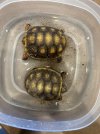TheArmedSparrow
New Member
Hi friends! After long deliberation and research,I recently settled on purchasing 2 red footed tortoise hatchlings. I live in North Texas and wanted a species that would do well in this climate outdoors with some added support indoors or with heat in the winter. The choice was between redfoots or a leopard but I liked the husbandry, variety in diets, and personalities of the redfoots.
Last Friday I brought home two redfoot hatchlings. There were 3 available and I picked the largest of the 3, but when I went to pick them up, the store accidentally sold one I had selected. The remaining hatchling was considerably smaller than the other two. He still had the pip on his beak and it looked like there was still a yolk sack remnant on his belly. Against my better judgement I decided to take him in exchange for the one that got sold plus his clutch mate.
They get soaked twice a day for 15 minutes and fed once a day. I’m feeding a variety of foods including spring mix, zucchini, melon, strawberries, soaked lugarti pellets, etc. plus added calcium. The big guy eats immediately. The little one hasn’t eaten a thing since I got him Friday (5 days?). Neither have have pooped yet, even in soaks. The big guy is pretty active. He cruises around his enclosure and likes to burrow under one of the ferns. The little one is active for soaks. Has no discharge from nose and has bright eyes. But isn’t eating.
Enclosure is 75 gallon with appropriate uva/uvb hood, basking bulb, and night infrared bulb. Temps on cool side are 78 to 82 depending time of day, and warmest on warm side was recorded at 88 degrees with my temp gun. Humidity (despite having an open top that I cover) is stable between 80 to 90%. I’m using Lugarti reptile soil. There’s plenty of hides and a mix of real and synthetic plants. I’m switching out all synthetic for real this week as soon as my last batch arrives. The areas that a tortoise could look out are blocked by crawling plants. All plants are approved for tortoises.
I’m currently building an outdoor enclosure to keep them in during the day. Humidity is high here and I think they will like the natural sun/shade. So that’s my current project.
Here’s the deal- I was given a 14 day health guarantee on the tortoises. I spoke with a rep who told me hatchlings take a while to settle in and to give it until Friday (day 8). I’m pretty sure these guys were clutch mates but that the little one hatched later and recently. Is there anything I can do to encourage him to eat? I feel terrible returning him, especially if he’s just really young and needs some time but if I wait too long I lose the guarantee and if he does I’m out a good amount of money. Thoughts?
Experience wise, they are my first tortoises but I’ve had reptiles before. I also worked in exotic veterinary medicine for nearly 2 decades so I’m not completely clueless but I need help!
Attached is a photo to show size difference.
Last Friday I brought home two redfoot hatchlings. There were 3 available and I picked the largest of the 3, but when I went to pick them up, the store accidentally sold one I had selected. The remaining hatchling was considerably smaller than the other two. He still had the pip on his beak and it looked like there was still a yolk sack remnant on his belly. Against my better judgement I decided to take him in exchange for the one that got sold plus his clutch mate.
They get soaked twice a day for 15 minutes and fed once a day. I’m feeding a variety of foods including spring mix, zucchini, melon, strawberries, soaked lugarti pellets, etc. plus added calcium. The big guy eats immediately. The little one hasn’t eaten a thing since I got him Friday (5 days?). Neither have have pooped yet, even in soaks. The big guy is pretty active. He cruises around his enclosure and likes to burrow under one of the ferns. The little one is active for soaks. Has no discharge from nose and has bright eyes. But isn’t eating.
Enclosure is 75 gallon with appropriate uva/uvb hood, basking bulb, and night infrared bulb. Temps on cool side are 78 to 82 depending time of day, and warmest on warm side was recorded at 88 degrees with my temp gun. Humidity (despite having an open top that I cover) is stable between 80 to 90%. I’m using Lugarti reptile soil. There’s plenty of hides and a mix of real and synthetic plants. I’m switching out all synthetic for real this week as soon as my last batch arrives. The areas that a tortoise could look out are blocked by crawling plants. All plants are approved for tortoises.
I’m currently building an outdoor enclosure to keep them in during the day. Humidity is high here and I think they will like the natural sun/shade. So that’s my current project.
Here’s the deal- I was given a 14 day health guarantee on the tortoises. I spoke with a rep who told me hatchlings take a while to settle in and to give it until Friday (day 8). I’m pretty sure these guys were clutch mates but that the little one hatched later and recently. Is there anything I can do to encourage him to eat? I feel terrible returning him, especially if he’s just really young and needs some time but if I wait too long I lose the guarantee and if he does I’m out a good amount of money. Thoughts?
Experience wise, they are my first tortoises but I’ve had reptiles before. I also worked in exotic veterinary medicine for nearly 2 decades so I’m not completely clueless but I need help!
Attached is a photo to show size difference.

